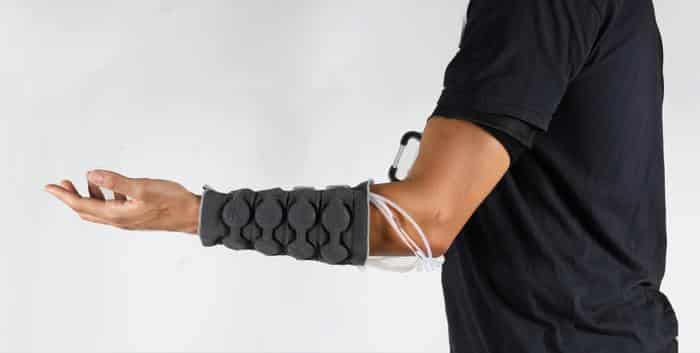Stanford Engineering researchers have developed Haptiknit, a comfortable and flexible knit sleeve capable of delivering pressure-based haptic feedback for enhanced user experiences in virtual reality and more. This innovation promises significant breakthroughs across various applications, from rehabilitation to remote communication.
Stanford Engineering researchers have designed an innovative, comfortable knit sleeve named Haptiknit, which may revolutionize how we experience virtual reality, rehabilitation and silent communication.
Unlike traditional haptic devices that mainly rely on vibration and tend to be bulky, Haptiknit utilizes a lightweight, flexible structure to deliver realistic pressure-based feedback.
“A device like this opens up a lot of new possibilities for user interfaces — how we experience virtual environments, how we experience remote communication,” senior author Allison Okamura, the Richard W. Weiland Professor of Engineering at Stanford, said in a news release. “It’s much more lightweight, wearable and comfortable.”
A Textile Revolution in Haptics
Creating a device that could deliver effective yet comfortable pressure feedback posed a significant challenge. The Haptiknit solution incorporates a battery-powered pneumatic system with small inflatable pouches — pressure actuators — strategically held against the skin within a custom-knit textile.

Caption: Haptiknit sleeve worn on the arm, including the control system on the upper arm.
Credit: Susan Williams, MIT Self-Assembly Lab
First author Cosima du Pasquier, a postdoctoral researcher at Stanford, drew from her experience in making clothing to envision using knit fabric to anchor the actuators in place.
“If you put air into a balloon next to your skin but don’t anchor it there, it’s going to expand in all directions,” du Pasquier said in the news release. “You’re going to waste most of the inflation potential.”
Through collaboration with MIT’s Self-Assembly Lab, the team manufactured the Haptiknit prototype on a knitting machine. The team chose nylon and cotton for flexibility and introduced thermoplastic fibers to create stiffened sections that keep the actuators in place.
Testing and Results
Testing the Haptiknit prototype involved 32 users who found that pressure-based feedback provided more accurate tactile location recognition than vibrational feedback.
Additionally, the researchers experimented with different inflation speeds to mimic continuous strokes, with faster, overlapping indentations proving more effective.
Intriguingly, users could recognize emotions like attention, gratitude and happiness through pressure signals, with a higher-than-chance accuracy.
“What was particularly interesting was that there was a correlation between whether someone had tried a haptic device before and how highly they rated the comfort of our sleeve,” Du Pasquier added. “Essentially, if they had tried out other haptic devices, they scored our sleeves much higher.”
Future Implications
With its increased comfort and effectiveness, Haptiknit opens avenues for advanced applications in numerous fields. Military communication, navigation aids and even dog training are potential uses for this technology.
The researchers are already brainstorming larger-scale versions of the device, such as a full suit for immersive virtual reality experiences.
They envision incorporating Haptiknit into assistive devices that support movement and rehabilitation, improving users’ quality of life.
“We can use this to start testing how people actually interpret and respond to this type of haptic information,” added Okamura. “Whether the purpose is entertainment, communication, training or physical assistance, this really brings these wearable devices toward things that people might actually want to use in their everyday lives.”
The research is published in the journal Science Robotics.

